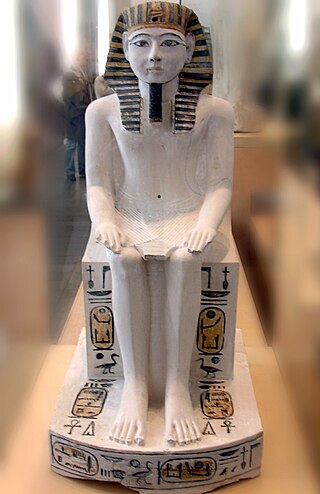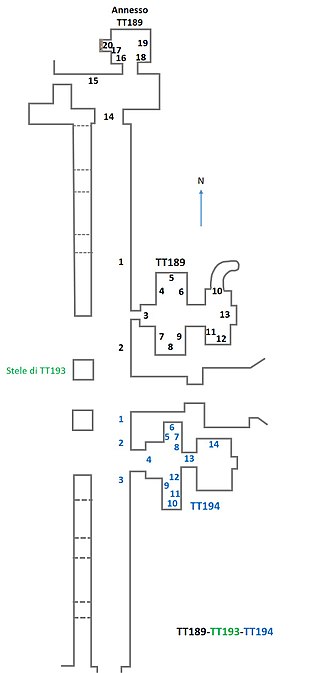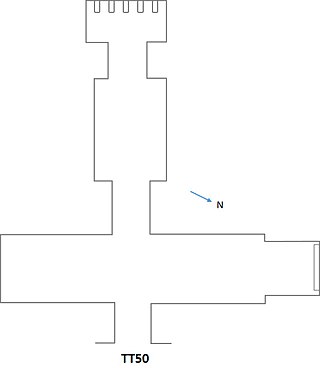
Thebes, known to the ancient Egyptians as Waset, was an ancient Egyptian city located along the Nile about 800 kilometers (500 mi) south of the Mediterranean. Its ruins lie within the modern Egyptian city of Luxor. Thebes was the main city of the fourth Upper Egyptian nome and was the capital of Egypt for long periods during the Middle Kingdom and New Kingdom eras. It was close to Nubia and the Eastern Desert, with its valuable mineral resources and trade routes. It was a religious center and the most venerated city during many periods of ancient Egyptian history. The site of Thebes includes areas on both the eastern bank of the Nile, where the temples of Karnak and Luxor stand and where the city was situated; and the western bank, where a necropolis of large private and royal cemeteries and funerary complexes can be found. In 1979, the ruins of ancient Thebes were classified by UNESCO as a World Heritage Site.

Amenhotep I or Amenophis I, was the second Pharaoh of the 18th Dynasty of Egypt. His reign is generally dated from 1526 to 1506 BC.

Nakht was an ancient Egyptian official who held the position of a scribe and astronomer of Amun, probably during the reign of Thutmose IV of the Eighteenth Dynasty. He was buried in the Theban Necropolis in tomb TT52.
The ancient Egyptian official named Menna carried a number of titles associated with the agricultural estates of the temple of Karnak and the king. Information about Menna comes primarily from his richly decorated tomb in the necropolis of Sheikh Abd al-Qurna at Thebes. Though his tomb has traditionally been dated to the reign of Thutmose IV, stylistic analysis of the decoration places the majority of construction and decoration of the tomb to the reign of Amenhotep III.

The mortuary temple of Hatshepsut is a mortuary temple built during the reign of Pharaoh Hatshepsut of the Eighteenth Dynasty of Egypt. Located opposite the city of Luxor, it is considered to be a masterpiece of ancient architecture. Its three massive terraces rise above the desert floor and into the cliffs of Deir el-Bahari. Her tomb, KV20, lies inside the same massif capped by El Qurn, a pyramid for her mortuary complex. At the edge of the desert, 1 km (0.62 mi) east, connected to the complex by a causeway lies the accompanying valley temple. Across the river Nile, the whole structure points towards the monumental Eighth Pylon, Hatshepsut's most recognizable addition to the Temple of Karnak and the site from which the procession of the Beautiful Festival of the Valley departed. The temple's twin functions are identified by its axes: its main east-west axis served to receive the barque of Amun-Re at the climax of the festival, while its north-south axis represented the life cycle of the pharaoh from coronation to rebirth.

The High Priest of Amun or First Prophet of Amun was the highest-ranking priest in the priesthood of the ancient Egyptian god Amun. The first high priests of Amun appear in the New Kingdom of Egypt, at the beginning of the Eighteenth Dynasty.

The Theban Tomb TT31 is located in Sheikh Abd el-Qurna, part of the Theban Necropolis, on the west bank of the Nile, opposite to Luxor. It is the burial place of the ancient Egyptian official, Khonsu, who was First Prophet of Menkheperre, during the 19th Dynasty or 20th Dynasty.

The Theban Tomb TT67 is located in Sheikh Abd el-Qurna. It forms part of the Theban Necropolis, situated on the west bank of the Nile opposite Luxor. The tomb is the burial place of the ancient Egyptian official Hapuseneb, who was High Priest of Amun during the New Kingdom reign of Hatshepsut.
Amethu called Ahmose was a vizier of ancient Egypt. He served during the reign of Thutmose II and the early years of the reign of Hatshepsut and Thutmose III of the 18th Dynasty.

The Theban Tomb TT156 is located in Dra' Abu el-Naga', part of the Theban Necropolis, on the west bank of the Nile, opposite to Luxor. It is the burial place of the ancient Egyptian Pennesuttawy, who was a troop commander and superintendent of the Southern Desert Lands during the reign of Ramesses II in the Nineteenth Dynasty.
The Theban Tomb TT168 is located in Dra' Abu el-Naga'. It forms part of the Theban Necropolis, situated on the west bank of the Nile opposite Luxor. The tomb is the burial place of the ancient Egyptian Any, who was a God's Father of Amun and a Chosen lector of the Lord of the Gods during the reign of Ramesses II in the Nineteenth Dynasty.
The Theban Tomb TT169 is located in Dra' Abu el-Naga', part of the Theban Necropolis, on the west bank of the Nile, opposite to Luxor. It is the burial place of the ancient Egyptian Senna, who was the head of the goldworkers of Amun during the reign of Amenhotep II in the Eighteenth Dynasty.

The Theban Tomb TT164 is located in Dra' Abu el-Naga', part of the Theban Necropolis, on the west bank of the Nile, opposite to Luxor.

Tomb TT189 is located in the necropolis of El-Assasif in Thebes, Egypt. It contains the sepulchre of Nakhtdjehuty, who was an overseer of the carpenters of the northern lake of the god Amun and the head of the goldworkers in the Estate of Amun during the 19th Dynasty reign of Ramesses II. Nakhtdjehuty's tomb is part of the TT192 tomb complex.

The Theban Tomb TT50 is located in Sheikh Abd el-Qurna, part of the Theban Necropolis, on the west bank of the Nile, opposite to Luxor. It is the burial place of the ancient Egyptian official Neferhotep, who was a Divine father of Amun-re during the reign of Horemheb of the 18th Dynasty.

The Eighteenth Dynasty of Egypt is classified as the first dynasty of the New Kingdom of Egypt, the era in which ancient Egypt achieved the peak of its power. The Eighteenth Dynasty spanned the period from 1550/1549 to 1292 BC. This dynasty is also known as the Thutmosid Dynasty for the four pharaohs named Thutmose.

The Theban Tomb TT385 is located in Sheikh Abd el-Qurna, part of the Theban Necropolis, on the west bank of the Nile, opposite Luxor. It is the burial place of the ancient Egyptian Hunefer (Haunefer), who was a Mayor of the Southern City (Thebes) during the reign of Ramesses II in the Nineteenth Dynasty.
Theban Tomb TT382 is located in Qurnet Murai, part of the Theban Necropolis, on the west bank of the Nile, opposite to Luxor. It is the burial place of the ancient Egyptian High Priest of Montu named Usermontu, who lived during the 19th Dynasty and served under Ramesses II.
The Second Prophet of Amun, also called the Second Priest of Amun, was a high ranking priestly official in the cult of the ancient Egyptian god Amun. The Second Prophet of Amun office was created in the New Kingdom, at the beginning of the Eighteenth Dynasty.

Tomb A.24 is the modern number given to a now-lost Theban tomb in Dra' Abu el-Naga'. The burial dates to the ancient Egyptian 18th Dynasty and belongs to the second priest of Amun Simut. The tomb was already known in the early 19th century and was visited by several early travelers, such as Jean-François Champollion and John Gardner Wilkinson. Especially the latter made several copies of the painted decoration. He seems to have seen the tomb in a fairly good state of preservation while it was already more destroyed when Jean-François Champollion came later. He copied some inscriptions. Several scenes can be reconstructed from these early accounts. There was a depiction showing the family of Simut receiving offerings, most likely in connection with a Valley Festival festival. A second scene shows the family of Simut hunting in the marshes. John Gardner Wilkinson drew the scene and later published it. A third scene must have shown vintage. Wilkinson only copied a minor detail. Another scene shows Simut in front of scribes, men weighing, and Nubians bringing tribute. The scene most likely relates to the office of Simut, who also looked after the magazines of the Temple of Amun in Karnak.













